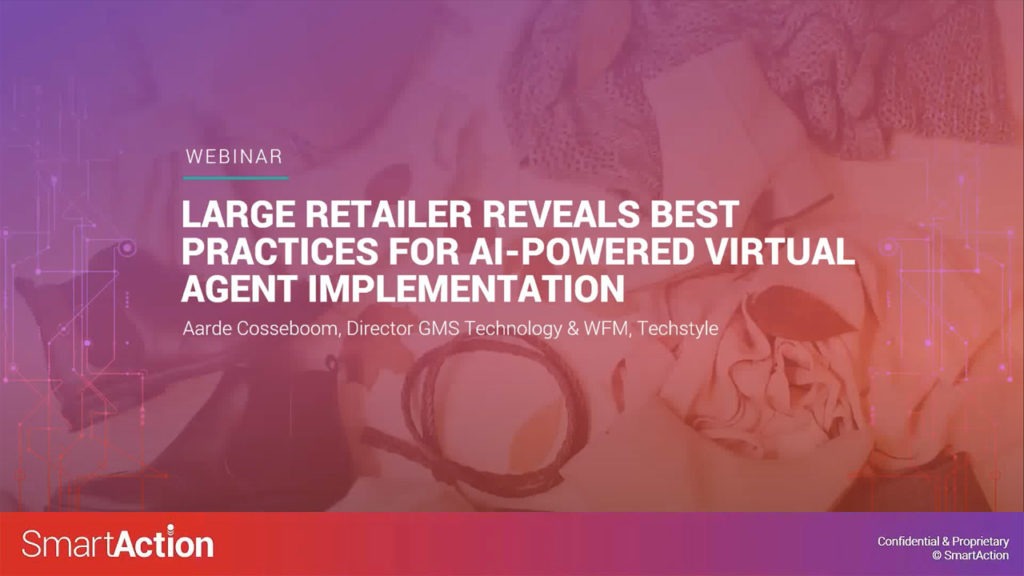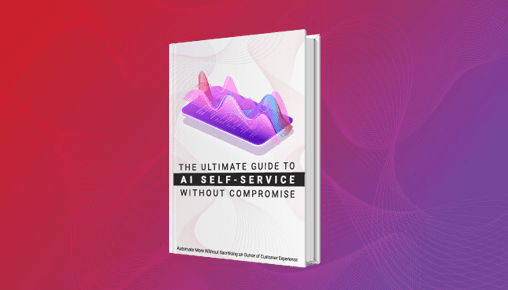Large Retailer Reveals Best Practices for AI-Powered Virtual Agent Implementation

TechStyle Fashion Group, operator of brands like ShoeDazzle, Fabletics, and JustFab faced monthly call spikes that were difficult and costly to handle with live agents. With cloud-based virtual agents, TechStyle automates their top call drivers over voice and chat, reducing their reliance on live agents in the contact center.
Hear from Aarde Cosseboom, Director of Global Member Services Technology, TechStyle, in an interactive Q&A-style webinar to learn:
- Best practices for implementing AI automation
- How TechStyle mixes virtual agents with live agents
- Savings and CX results
Key Takeaways:
- Learn how TechStyle replaced a touchtone menu with natural language intent capture
- Find out how TechStyle identified perfect call types for voice and chat automation
- Hear about TechStyle’s results from both a bottom line and CX standpoint
Watch This
Webinar

Aarde Cosseboom
Director of GMS Technology & Product,
TechStyle Fashion Group
Large Retailer Reveals Best Practices for AI-Powered Virtual Agent Implementation
On-Demand Webinar
Brian Morin: Hello everyone. My name is Brian Morin. I’m the Head of Marketing here at SmartAction. I am your host today. Today’s topic is a customer spotlight webinar, something that we’d like to do every couple of months, customers of ours who have implemented AI powered virtual agents to automate more in their contact center. And today we’re going to be profiling TechStyle large retailer who’s going to share their best practices around their AI powered virtual agent implementation. And this session is going to be in a Q&A format. So, I’m just going to pepper our guests here Aarde Cosseboom. Aarde Cosseboom glad to have you with us today. Make sure that you’re coming through over your mic. Can you hear me okay, Aarde Cosseboom?
Aarde Cosseboom, I know you’re with us, we were just chatting Just a second. Let me make sure that we get you connected and let’s get your audio synched up. We are having, looks like just slight technical difficulty with Aarde Cosseboom if you hold on tight for just a few seconds here we’ll make sure we get it resolved.
Kim: Brian Morin, this is Kim it looks like he’s back on.
Brian Morin: Okay.
Aarde Cosseboom: I’m here. I’m so sorry for that.
No worries. We had you, we lost you but we got you back. So all I just wanted to do here is just set up for those who have joined in or you obviously they’ve joined it not to hear from us smart action they’ve joined, didn’t you hear from Aarde Cosseboom and Aarde Cosseboom I’ll introduce you in just a second to share a little bit about yourself and tell us a little bit about TechStyle. But those who have joined in might want to, you may be wondering, well, you know who is SmartAction who’s hosting this in the first place. And I do not like belaboring long company overview slides. So I’ll make this quick. SmartAction started as an AI research company back in 2002. So we’re not the New Kids on the block when it comes to AI development, machine learning, natural language processing.
Brian Morin: And where we fit is with companies who are already using a contact center platform or IVR. It might be a Genesis or an Avaya. In the case of TechStyle, it’s nice and contact with them and so on. And those organizations lean on us to expand their self service automation in those environments. So, on the lower left, you can see our awards and recognition on screen. But if you do you want further evidence just beyond what the analyst community says and you want to know what your peers think, all you have to do is Just Google Gartner Peer Insights. It’s one place where you can go and see vetted reviews, and see who is the top rated and most reviewed virtual customer assistant solution there, among the likes of IBM Watson and other.
So I just needed to get that shot in. So Aarde Cosseboom, what I want to do is introduce you to our audience. They’ve joined in today to hear a little bit about your implementation with AI powered virtual agents and what you’ve seen in experience, but first, I want you to tell us just a little bit about yourself and tell us a little bit about TechStyle
Aarde Cosseboom: Yeah, absolutely. First of all, thank you Brian Morin and team at smart action for hosting us and I would be glad to answer any questions here on the webinar, but also if anyone has questions afterwards, I love this. This is my bread and butter. This is what I wake up and enjoy doing every single day, day in and day out. So yeah, a little background of myself. I’ve got 10 plus years of contact center experience. I focus specifically on global customer service teams and technology. The larger the contact center, the better. I love supporting not only the contact center as my direct customer, but also the customers of the companies that I support as well too. I’ve been here at TechStyle for a little over a year and a half going on two years now. I’ll go into the TechStyle, what we do, what our brands are, and a little background into that. And a little bit and as you could see, there’s a list of five different brands that we support.
Before that I worked at Cornerstone OnDemand, which is based out of Santa Monica, LA region down here in California. It was a software as a service company serving b2b type of platform. What we did was help support people from a more tech support typestyle support infrastructure versus what we do today here at TechStyle. And then before that I worked at Mindbody for about eight years. Mindbody is a software as a service as well, b2b. So business to business supporting tech support style, as well. Basically the yoga fitness, gym and pilates business owners and helping them with their software. So lots of experience in multiple different types of b2b or b2c, direct to consumer e-commerce, software driven companies and also TechStyle which I’ll go into next.
Brian Morin: Yeah, well, let’s do that Aarde Cosseboom. Your TechStyle is a large online retailer. Those that may not have heard of TechStyle, they likely have heard of your underlying brands, Fabletics, JustFab, ShoeDazzle, and more. Just tell us a little bit about TechStyle.
Aarde Cosseboom: Yeah, so TechStyle Fashion Group we actually rebranded about two years ago, we used to be called JustFab. What we do is we successfully launch e-commerce website brands partnering with celebrities. So celebrities like Rihanna, Kate Hudson, Kelly Rowland, we also used to work very closely with the Kardashians. I know they’re in the news right now. But basically what we do is we come up with clothing lines and brands that fit the celebrity model. Specific celebrities that we know and work with very closely. And then once we have a curated storefront, e-commerce storefront, we partnered directly with them, and what they bring to the table is the e-commerce marketing, social media following, so forth and so on. And then we do all of the infrastructure. So we do all of the support. We have robust HR and people team. We do all of the curation, the warehousing, logistics, shipping, returns, everything from consumption of product all the way to end of client lifecycle or a customer lifecycle.
Brian Morin: So Aarde Cosseboom why don’t you just maybe jump right in and you can share with us some of their contact center your facts and figures?
Aarde Cosseboom: Yeah, so we are an e-commerce, clothing company. We’re actually five different companies, but we roll it all into one Corporation. And we have two different types of customers that contact us. It’s either customers contacting us because they have a specific question about a specific product. So for example, a shoe is in the wrong size, or maybe a shoe is sold out and they want to buy something or an article of clothing. So that would be one type of call email or chat. And then we also have a monthly membership. So people can basically purchase a membership where they get discounted rates on any of the fashion apparel that we have that we publish every single month. And those rates are anywhere from 60% to 80% off. So people are also calling and contacting us based off of billing information, membership details, they’re asking to skip the month which allows them to not necessarily pay for the monthly membership this month.
They want to skip and potentially pay next month instead. So we’ve got two ecosystems or two large umbrella customer types that contact us. As far as a scale and size. We support our members via phone chat and social. Those are the biggest ones in North America. We also support via email over in the EU. We’ve got about six million plus phone calls per year and it grows about by a million every single year. So last year, we were at … 2017 we were at five million, 2018 we had six million and then 2019 we should be a little bit higher, three million chats per year. Our conversations specifically over the phone last about nine minutes. So these conversations aren’t extremely lengthy, they’re also not extremely short. Again, that a little bit later as well. We’ve got five million members across the globe. So in addition to the people who purchase all a cart, we’ve got active members that are accessing and purchasing product monthly and to the five million mark per month.
We support in 12 countries and in seven different languages, mainly the EU specific languages, so Spanish, Italian, German, Dutch, and French.
Brian Morin: So I do want to just encourage the audience that if you do have any questions, or comments, all that you have to do is just click on that Q&A box icon and just submit your question and we’ll tackle that either as I’m going through this Q&A with Aarde Cosseboom or once we get to the bottom of the hour for anything we haven’t answered, we’ll stop there and answer all questions that come in. So as we go along, please do chime in. Now, I should mention Aarde Cosseboom that it is noteworthy that TechStyle won the CX Excellence Award for best cloud implementation, among the Dyson contact user base, maybe you can tell us just a little bit about that accolade and why it was given.
Aarde Cosseboom: Yeah, absolutely. So we won this award basically, it’s geared towards cloud technology implementation. And what we implemented last year was a chatbot with smart action. And what the chatbot did was service our customers reactively and proactively on our website when they’re shopping through e-comm or browsing through our FAQs. And what we found was within just four different types, and I know I’m jumping ahead, there’s question, I’ll dig into that a little bit deeper. But within four specific types of conversations that customers are trying to have with us via chat, we were able to deflect over 25% and self serve those customers through a chatbot without actually having to service them through a live agent. So, that was extremely large. The volume of savings and when we’re talking about three million chats year over year, reducing the inbound chat workload by 22% is pretty huge.
Brian Morin: Yep, it is. So Aarde Cosseboom, why don’t we go ahead and just start with at the highest level. First just talking about which call types and chats are you automating with AI powered virtual agents right now?
Aarde Cosseboom: Yeah, this is a great question. It’s a good area to start. So I mentioned earlier that we have two different types of customers that are contacting us, those are our monthly members who are contacting us asking things like, can I skip the month? Can I change my billing information or my credit card on file? Maybe can I change my shipping address to where you send all the products? Or maybe I moved in the recent time. Those types of questions. We also have customers that are shopping all the carts, so people who are talking specifically to us about specific items that they purchased in the past, those could be returns and exchanges. Maybe they never got their order so they need us to reship them a new pair of shoes or a new pair of leggings, whatever that is. Or maybe they just want to call in and ask, “Where is my order? Is it on the way, where’s the shipping details? Have you received payment for it? Is everything good?” Those types of questions.
So we service our North American customers, our English languages with not only an IVR, which is a virtual agent in our IVR, through SmartAction to help service those types of questions, but we also do it via chat through our chat bot. So I won’t go over the specific examples of what happens when they call in quite yet. But essentially, when someone calls in or when someone chats with us, and they have a specific question like, Where’s my order, the system is going to automatically pull information from our database and then return that information in the same channel with which they contacted us.
Brian Morin: Sure. So and in just a minute we’ll jump into talking about how the solution actually works. But everybody or I should say anyone who has yet to make the transition to your voice and chat automation, some of this could just be a great big black box, not necessarily even knowing where to start. How did you first identify the right call types and chats that you felt were perfect for AI automation?
Aarde Cosseboom: Yeah, and this is a great question. And there’s tons of ways to try to solve this. There’s lots of ways that I wouldn’t necessarily say are wrong, but ways that we tried first and then we found out it didn’t give us the right answers or what we were looking for. And then we finally stumbled upon the right approach here. So traditionally, people think, “Oh, well, let me check to see what people are contacting, for chat, for example, they’re contacting us via chat for these types of reasons and maybe we could service them through FAQ’s and essentially, if you think of it through that lens, you’re really just creating an FAQ bot which is helpful in some situations, but not necessarily helpful in others.
For us, we found that we have posted FAQ is on our FAQ page. People aren’t necessarily failing over to chat or failing over to phone calls. If there’s not enough information in that, that FAQ bot. So what we said was, “Okay, what’s the next step? Why are these people contacting us?” The information is either in FAQs and they didn’t even look forward or find it or discover it. But the majority of these tier one call questions are more specific. So, it’s not necessarily how long does it take to ship my order, but specifically for myself Aarde Cosseboom, where is my order? Is it in transit? Is it not in transit? That’s a next layer beyond tier zero, which is FAQ bot and a tier one question that needs a little bit more context behind it. So what we did was we have contact centers in the Philippines and in the EU and Belgrade and we also have contact centers down in Tijuana.
And what we did was we took executives on a trip, 16 hour flight over to the Philippines, sat them down. This is sea level and up. So we had our CEO, our COO, our CTO sitting down and listening to calls. And within an hour, they could identify specifically what the repeat callers were. Remember they’re nine minute calls. So in an hour, you’re listening to quite a few calls. Yeah, and what they found was just in that observations, three or four different sea levels, writing down what the common calls for, we found what the top four reasons why people were contacting us, and how we could potentially automate that. So that’s how we identified what the specific call types or chat types were and the best thing about that experience is that after we came out of that one hour of shadow session, we already had executive buy into to looking towards partners to help us solve this issue.
Brian Morin: Right. That’s a great point Aarde Cosseboom. Now, so this question might be somewhat duplicative. You did answer it a little bit, but maybe you can state just what was the challenge you’re facing where you looked at those top four, the routine repetitive calls that were coming in and what we need to be looking at AI powered automation to help assist us here?
Aarde Cosseboom: Yeah. And piggybacking off of that example, we went to a meeting room and discussed, these are the areas that we could solve for. These are the four potential types that we could solve for. So how are we going to solve for them and we didn’t necessarily say, all virtual agents. That wasn’t the first thing that came to mind. The first thing that we said and this is traditional and troubleshooting, especially in the contact center spaces. Okay, well, we just need to create very robust and strict scripts for our agents to respond to it. So let’s get these nine minute calls down to five minute calls. Because if we know the four exact questions, and we know how to formulate those conversations, why don’t we just do really good quality monitoring, we do some really good training, we get agents that are really good at those specific types and do skills based routing. So like one person only answers a where’s my order type question. Another person only answers, maybe a refund question or a re-ship question doing agent segmentation.
And the way that we were troubleshooting this, we could have driven cost down, we could have become more efficient, but what we were doing is really not automating, we were just enforcing the manual piece or the manual response that was needed by the contact center. So we decided to think outside the box to potentially leverage AI. We are a technology focused company and a KPI driven company. So our goal was to potentially automate these what we call tier one type questions and drive up self-service.
Brian Morin: So Aarde Cosseboom, the solution that you’re using with SmartAction, it is an omni channel automation solution that you automates over voice and then your carries that same experience digitally over chat or text, is there any reason that you can speak to why you went with a third party, your cloud based company for AI powered self-service, instead of you going the traditional route when it comes to voice automation, which is going through your contact center platform vendor, you’re buying some, your speech recognition license, paying for the professional service to program the logic to build it yourself?
Aarde Cosseboom: Yeah, great question. We do have a pretty robust technology team, product team here internally, so we could have built it out, it would have taken us a very, very long time. We probably would have hit some pretty large stumbling blocks. So to quickly answer your question, I would say, in a couple of areas, the first bullet point would be, we wanted to go to market rather quickly and potentially AB tests to prove out the concept of doing AI, virtual agents versus just internally resource wise taking months and years to develop our own. And then the other thing was, we knew that there was third parties out there that could integrate with our technology systems like you had on your first slide. All the IVRs and ECDs out there in the world who’ve already perfected it. So yeah, we wanted to vet it out, but also be able To AB test and tweak things and focus less on the technology and development side and focus more on the customer experience side.
Brian Morin: Yep, good. Well, Aarde Cosseboom how about we just go ahead and dive in and talk about how the solution actually works. Perhaps you can walk me through your examples, one or two call types and just talk about how a virtual agent handles it.
Aarde Cosseboom: Yeah, absolutely. So, I think I’ll give you an example of the more complex one which is our phone virtual agent embedded in our IVR only because that’s where we started and then we went to chat bot. We wanted to tackle the most complex one first in the highest contact volume channel first. So basically, someone will call into our IVR and the first thing that the member experiences or the customer experiences, thank you for calling JustFab. How may I help you? So very simple, open ended question and the member or customer can say pretty much anything. What we have found is the majority of the time they say with a high level of confidence, things that fall into four different buckets. For this example, I’ll just say where’s my order?
So the member say, “Where’s my order?” It’ll do what we call is a data dip, it’ll take a look at the phone number that called in and reference that to the database that we have our CRM, and then it’ll pull to see if there’s an active order. And if there is an active order, it’ll return back in natural language, we found that you ordered something last Wednesday, it is currently being fulfilled in our fulfillment center, you should get the package in four days.
If they have multiple packages, it’ll return multiple packages. And so it’ll say, it looks like you ordered four different packages over the last month. There was a package that was ordered on the 1st of the month, the 8th of the month, the 12th and yesterday, which one are you referencing? And then they would say, “I’m referencing the one from yesterday.” Then it would pull that record and say, it’s still in transit, or it’s already shipped in halfway there or something like that. So, that’s how the self-service solution works. It leverages natural language, it leverages our IVR. So there’s no more press one, press two, press three every time everyone pushes zero, because they just want to talk to someone. Instead, it actually does the work that the agent would be doing, solves the issue and either self-service contains or if it’s a complex issue that doesn’t have a necessary answer and can’t self-service, he’ll say, it looks like that’s a complex issue. Let me go ahead and send you over to an agent and then puts them into queue.
Brian Morin: Got you. Aarde Cosseboom, some contact centers do have some hesitation particularly around implementing voice automation, maybe sometimes for the sins of the past that the technology just isn’t very good yet or not good enough. Yet, obviously everyone’s chief concern is around customer experience. How would you answer those that are holding back on at least the voice automation piece for these reasons?
Aarde Cosseboom: Yeah. Something I said earlier is, try not to be fearful but also a B test. So, if you are fearful, you can set up these environments where we only push 10 calls a day, and then you listen to those calls and see what the experience is or you reach out to those 10 customers directly via email and say, “Hey, you just went through a beta test. How did you like that experience?” Collect that feedback and then move so you could stagger these types of developments or releases. That’s what I would recommend. For us, we have found that the technology, specifically the voice technology, is actually way better than what we use today. In SmartAction, you guys help us with this, we actually have to put a robotic accent, if you could call it that, to help the customer know that they’re actually working with the robot or working with an automation and they interact in a different way when they know that up front versus it been to natural language and it feels like you’re actually talking to a real human.
And then when you find out Oh, you have to transfer me to another human, that’s confusing, because I thought, I was just tricked into thinking that I was already talking to a live agent. So, I would say test it out, tweak it in a way that makes sense for your business. We personally, we call it AIana. So we put a real human name to it but you don’t have to. You could also in your voice agent in the beginning, you could say things like, before I route you or while you wait in the queue, let me try to solve all your issues via this AI.
Brian Morin: Right. Aarde Cosseboom, just at the both top level, maybe you can just share with our audience, why did you choose to work with SmartAction? And then we’ll get into some of your key observations and results.
Aarde Cosseboom: Yeah, and I touched on this a little bit earlier, when we were going to market, when we were trying to solve this issue, once we discovered that we had this issue, and we were figuring out ways to troubleshoot or solve this potential issue, we decided that we wanted to go with AI and we wanted to go with natural language. So SmartAction was one of the top two or three companies that have mastered it. This was about four years ago. Things have changed and you guys have really proven to be the leader in this area. But when we were shopping around and trying to understand who can potentially help us, we were looking at different potential vendors and those different vendors have different levels of engagement. And the reason why we chose SmartAction was very tricky, out of the box didn’t have to focus too much on development, which was key for us because this is something that was extremely new to us, I’m sure it’s very new to a lot of the people who are probably listening to this webinar.
We didn’t want to go with a partner who was a little bit more hands off in that we would have to do a lot of the development work around the call flows and the scripts and data dips into our CRM. A lot of other potential partners, they rely heavily on you and your IT teams to solve for that. And we didn’t have those resources, at least not at that time. So we decided to go with SmartAction. Now that we’ve been with SmartAction for multiple years, we’ve internally trained key members on our GMSR Global Member Services team to be able to go in and configure those call flows and tweak them in a way And one of the reasons why we enjoy using SmartAction is that that person who’s going in there and tweaking those call flows. They don’t have to be extremely technical. They don’t need to know SQL, C++ or React or any of that stuff. They just can go in and say, “Oh, I want to make this change to this and that and then change the variable that it returns and I’m done.”
Brian Morin: Good. Well, Aarde Cosseboom, while you go ahead and just share some of your key observations and results, you’ve obviously been doing this a while, you’ve grown and evolved. Maybe you can give us just some of that high level takeaways on results from implementing virtual agents.
Aarde Cosseboom: Yeah, absolutely. So, the huge key results are the key observations were the self-service containment and deflection right off the bat. Beyond that, we were just focused on customer experience. So we sent out customer service member satisfaction surveys after they interacted solely with the chatbot or the virtual agent, and got glowing reviews. People were extremely happy that they were able to do things on their own and they didn’t have to actually talk to a live agent to solve some of these easy transactional type requests. It’s very frustrating when people have to pick up the phone to call, wait two minutes, then talk to a real human for nine minutes just to figure out where their package is. Being able to service customers in those types of inquiries very quickly in ad hoc, in an ad hoc fashion was huge.
And what we found and this was at first we were scared of this and it came true was that more people were contacting us but they were only contacting us to talk to our virtual agent. They weren’t actually contacting us to talk to a live agent. They were just calling in everyday to check where the status was on their package which increased our contact volume, which is great and it was only great because we self-service them multiple times in a row. So, interesting to see the customer dynamic change after they know that you’re giving them this level of support.
Brian Morin: Right. Aarde Cosseboom, do think that you’re able to ballpark any cost savings number, even perhaps like single year cost savings numbers that you’ve been able to see in the TechStyle, within TechStyle?
Aarde Cosseboom: Yeah, it’s a little bit tough based off of the natural growth that we have and seasonally, we peak in boot season, but we did launch chatbots. So before we had chatbot, we had a decent baseline of cost. After we launched chatbot and we had a full year of it run in 2018, we found that we saved at least a million dollars in headcount costs based off of self-service deflection, and that was just the chatbot function. So, going back to the metrics before, it’s really one third of our total volume, that three million chats per year versus our six million phones. So we really have nine million contacts coming in through those two channels and we saved about one million for chat and probably in the two million range in voice for 2018 if I just ballpark it.
Brian Morin: Now, Aarde Cosseboom, we want to bring up here. This is going to be notable for audience that you’ve recently written a book for contact center leaders. And I know that it’s just on the edge of being published or Aarde Cosseboom, I don’t know if it was already published this week, you can let us know. It’s on the topic of enabling better customer service. And I know that you have one of the chapters dedicated to AI powered self-service and I don’t know if you can share some of the highlights from that chapter of some of the need to know information on best practices.
Aarde Cosseboom: Yeah. So yeah, it should be published in the next week and a half. It will be published through Amazon. I’m sure you guys will all see it there, it’s SmartAction via my LinkedIn and personal emails will ping back and forth. But yeah, it’s a … basically it’s just a digest of what things work and what things don’t work, at least in my experience over the last 10 years in multiple different companies. There are a lot of technical chapters. So there are some you could dig really far into those. But the majority of it is really high level. So strategic, what works, what doesn’t work. It runs the gamut of people product and process. A lot of the product stuff is the technical stuff, how to do integrations, how to do data dips, how to select partners and vendors when you’re looking for new partners and new vendors, how to set up an ecosystem or technology stack for your contact center. So how do you structure your IVR, your WFM, your third party partners your data layer?
So it does get detailed and complex in those areas. It also highlights a lot around the people side of the house as well too. So, how to recruit A players, how to retain customers, a lot of the HR facets of the contact center customer service, executive roles and responsibilities. So, lots to dive into its rather long, it’s 16 chapters in almost 300 pages, lots of visuals as well too, but there’s some whimsical stuff in there as well. So, a little bit playful in the writing style.
Brian Morin: So, we will let everyone that is attending today is whenever Aarde Cosseboom’s book is published, we will be sending out a follow up email to you to alert you so you do know where you can be make that purchase and when you can. I know that we’ve gone just past the bottom of the hour just a little bit. So, if you do have a hard stop, we appreciate you taking the time for joining in, as you could. If you’re looking to engage SmartAction, you may want to do a call study to investigate the call types and chats that are taking place in your organization to find out where is there the perfect fit between your call types and AI automation. Also, you just may be interested in seeing a demo and hearing the experience both over voice. We’re seeing it in chat, you can go to the smartaction.ai website and contact us there. And just let us know the reason for your engagement and we’d be happy to assist in any way that we can.
What I’d like to do is just move to a Q&A session. So, any of those of you that have been listening in, any questions that you may be sitting on, this is your chance to throw it Aarde Cosseboom’s way and get answered. He’s been in this area doing AI powered automation for a while, certainly one of the forerunners of doing that, and showing how agile that they are over at TechStyle in regard to what they do in their contact center space. So Aarde Cosseboom, while we wait on questions to come in, if there are any, I can think of one that your audience would likely be interested in hearing, knowing that you’ve made that transformation and knowing that you’ve grown and developed over time, are there any big challenges or hurdles that you can speak to that you ran into while you’re rolling out virtual agent automation that you had a work to overcome?
Aarde Cosseboom: Yeah, nothing from a technical side. We actually went up and running pretty quickly, I would say, internal buy in and that AB testing timeframe was a little hectic because we were really putting our customer service and customer experience in the hands of a third party which we’ve … it’s very customer facing and something that we’d never done before. So, there was lots of C level executives who had eyes on it, there was lots of analyst internally, business analysts that were running numbers and KPIs to understand, is this working? This is not working. So exciting times, I wanted to say hurdles other than we didn’t expect the amount of time and resources needed internally to just answer and fill those questions internally and run ad hoc reports to see how successful this pilot was. And that really lasted for a solid month in the thick of it and then has forever been a part of our KPIs and metrics moving forward.
So, we assess these things at all different levels internally every single week and it’s just awesome to see the engagement back and forth and people who will come up and say and like, “Oh, well, what if we just tweaked this call flow a little bit?” So now, we’re starting to AB test the details of the call flows and maybe rewording things to customers so that … shipping as an example used earlier, maybe saying a different word when we’re responding to the customer with regards to where their package is, so it’s a little bit lighter or something like that. So we’re engaging at different levels and then bringing that all the way through to SmartAction, our partner to help develop an AB test.
So yeah, no extreme hurdles. I would say nothing but good and positive feedback throughout the whole experience but it was a little bit extra work than what we originally planned for.
Brian Morin: So Aarde Cosseboom, do you feel like you’ve automated everything that you can automate right now? In other words, is there a roadmap in place on where you’re going next or do you feel that you’re doing everything that you can do at this point?
Aarde Cosseboom: Yeah, there’s always more for us to do. We want to expand not only channels, so we want to expand outside of the voice, the inbound voice and the inbound chat. We want to do callbacks. So we want to automate the way that we call our customers back so they could initiate a callback while they’re waiting in queue. And then when we call them back, we could have the AI virtual agent validate if the person who we call back is available or if it goes to voicemail or all these different options. So, that’s something that we’re expanding too on the channel front. We also want to expand to different languages. We have this for North America today. We want to expand this to Australia and the UK so that we can support those customers with AI virtual agents and chatbots and automation, eventually migrating over into the other core languages as well too. So German, French, Italian, Spanish, so forth and so on.
Also, call flows themselves. So as our business changes or as we have promotions and things that come out. We know that during our boot season, we have a lot of promotions where people get two boots for the price of one. They call in and they want to know what those promo codes are, how to use them, or maybe they try to apply a promo code and then didn’t work. So there’s all these different types of call flows that we haven’t necessarily rolled out to our core for that we can improve upon. So yeah, lots of expansion, lots of things in our future roadmap, I would say across the gamut of multiple languages, multiple channels and multiple different call types.
Brian Morin: Good. Aarde Cosseboom, I don’t see any other questions that have come in at this point. I do want to just mention to the audience that we will be following up with you on demand version of this so that you can replay or share with stakeholders, you should be prepared and be able to be sent to you tomorrow. And if you are looking for engagement, we do have a very consultative approach that starts with simply examining your call types and chats, finding out is there a perfect fit for AI automation in your organization, putting together a business case and an ROI that makes what we will call just no brainer sense. So if you would like to engage, SmartAction, just visit our website smartaction.ai, and we’re happy to engage you there. And again, as I mentioned, if you’re looking for some kind of demo of the system, happy to oblige there as well. Aarde Cosseboom, any closing remarks on your side before we go?
Aarde Cosseboom: No, just thank you to SmartAction, thank you Brian Morin, Kim for hosting, to the audience as well too. I obviously don’t work for SmartAction, but I do roll out technology for contact centers. So if you guys have any questions or want to ping me externally of SmartAction, I could always engage you with any questions that you may have. Feel free to reach out to me on LinkedIn or directly via my email. And I think I had that on the one of the original slides up top. But yeah, thanks again to SmartAction, and Brian Morin for hosting and hopefully this was informative. And let me know if you guys have any questions or comments.
Brian Morin: Aarde Cosseboom, I can’t thank you enough for taking the time. I know that our audience appreciates it and we appreciate it. So, thank you so much for joining us today and sharing your experience. So thank you for everyone who’s joined in and we look forward to having a continued conversation with you. Thanks, everyone. Have a great day. Thanks, Aarde Cosseboom.





